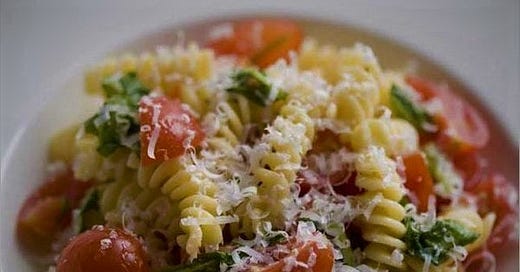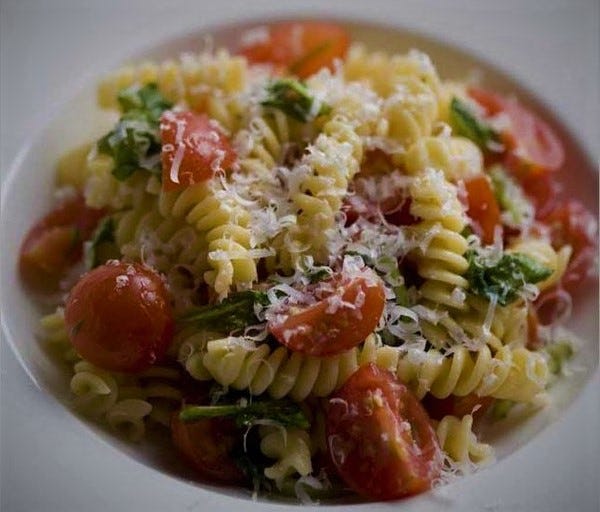OK so for today I've got another recipe for ya. We all should know, and more than likely have heard me mention before, that it's a good idea to be mindful of our macronutrient mix throughout the day. I am defining a macronutrient mix as the percentage of calories that come from macronutrients (proteins, fats, and carbohydrates). Getting this mix well suited for your own mind, body, lifestyle, and activity levels is crucial. So is consuming the proper amount of total calories per day (more on this in the future).
Over the past twenty years carbohydrate consumption has been under assault. Unless you have food allergies borne from certain grain-based foods, I would advise against cutting carbs out altogether. Why? Because they are a major source of energy your body needs to perform, and repair itself, on a continual basis.
Not all carbohydrate sources are created equal of course. But, I really want to talk about one that has been around for centuries. That being pasta, or noodles. Specifically of a grain-based variety regardless of its gluten status. The kind that is produced from either wheat based (contains gluten), or rice based (sans gluten), flour. Salt. Water. And perhaps eggs.
Italy is well known for pasta dishes that the world has gone mad for. To my knowledge they have cornered the market in this high-quality wheat-based carb option. Their pastas are comprised of, as mentioned, flour, water, salt, and maybe eggs. All of which is combined to form a dough that is then cut into a shape of some sort and boiled off.
However, correct me if I am wrong here, but pasta (or noodles) date back further to China. And, also correct me in the comments if you must, but I do believe they are more well known for noodles that are of the rice based variety.
Between these two types of carb varieties lies one similarity…their position on the Glycemic Index (GI). Foods that are high on the GI scale are things like pure glucose, white bread, and white rice. However, pasta (and noodles) that are made from the same type of flours score considerably lower. For reference, the higher on the GI scale, the faster a carbohydrate source is processed and released into your bloodstream as glucose. Unless you are performing in some sort of physical endurance event, this is bad on a daily basis.
Pasta (and noodles) have a lower GI value due to gluten and proteins formed during the kneading process among other things. These considerably slow down the digestion time. In a race between consuming two slices of bread vs pasta for an equal amount of carbohydrates (in grams), the carbs from the pasta will be released into your bloodstream at a slower rate. This is a good thing. You will feel fuller for longer for starters. By comparison, the carbs from the slices of bread will be processed so fast that your body may not have use for all of it in that instant. The remainder of that glucose will be stored as body fat for later use. So if you consume fast burning breads and bakes on a regular basis, and are rather sedentary for most of the day, this will slowly wreak havoc on your body over time.
With pasta (or noodles) there is a little more wiggle room in the world of carbohydrate consumption. You still have to watch how much of it you eat in total, but at least it will be a slower burning carbohydrate source which will be much better for most of us out there.
The pasta and noodle dishes that exist in this world are vast. Here is an example of one such version I used make all the time. And when I eat pasta, I much prefer the whole wheat, or whole grain variety. This ensures that the flour used has the most amount of nutrition available. Semolina is a close second. OK, here is the ingredients list.
Ingredients
→ Whole Wheat pasta of choice (I like Bow-Tie or Fusilli for this dish)
→ Cherry Tomatoes (halved)
→ Baby Arugula
→ Extra Virgin Olive Oil
→ Garlic (or in a pinch granulated garlic)
→ Onion (or in a pinch granulated onion)
→ Salt, Pepper
→ Dried Oregano OR Dried Basil
Instructions
Step 1:
Boil off as much pasta as you think you'll need. Follow the instructions on the package for cooking times. Personally, I put a little salt in the water. But, a fist full of salt like I have seen some Italian chefs do seems excessive (you will see why in a moment).
Step 2:
Drain the water from the pasta. Do not rinse the pasta with fresh water once you do so, you want to retain some of the starch on the surface of the pasta. If you've used a colander to do this step, put the pasta back in the pot it was cooked in (you want the heat that is still retained in its metal).
From here on out, the pot should be off of a burner. No heat shall be applied to it.
Step 3:
Add just enough Extra Virgin Olive Oil to just coat the pasta. If you are nervous about this step, add a little at a time and mix until the pasta has a uniform sheen from the oil on its surface. If you end up with a pool of oil at the bottom of the pot that is too much really (not the end of the world but keep this in mind for the next time).
Step 4:
Add in Salt, Pepper, granulated onion, and granulated garlic (I am often too lazy to mince fresh onion and garlic). Then mix and taste. Use your own pallet to judge what you feel is lacking out of these and add in some more if needed. There is no right or wrong here so just trust your judgment.
Step 5:
Add in dried basil, or oregano, baby arugula, and halved cherry tomatoes. Mix and taste. My preference is to have the pasta the star of this dish, so I use baby arugula and cherry tomatoes as an accent. Be sure to taste again. You may find in this step that a small amount of oil or seasoning needs to be added. If so, make an adjustment and re-taste. Repeat until you are happy.
Step 6:
Allow this to rest in the warm pot for five minutes.
Step 7:
Serve all by itself or with grated parmigiano and enjoy.
Honestly this whole process should take about 15-20 minutes tops. While the pasta is cooking you can prep everything else which will make use of otherwise dead time.
This is such a delicious and nutritionally dense way to get in a quality source of carbohydrates without worrying about it digesting too fast. And, it would make a great pairing with the lamb burger I wrote about in my last food post (linked below).
To help grow this newsletter please Like, Comment, Share, and Subscribe.
To help support this newsletter, consider becoming a Paid Subscriber.





